The first two weeks of this class have been dedicated to the ancient Greeks. We have focused on the intellectual accomplishments of Greek philosophers, specifically their explanations of physical phenomena, their models of the cosmos, and their mathematics. Now we need to ask, how did these ideas become so influential? How did they become the foundation for western science? To answer this, we need to look beyond the ideas of Greek philosophers to the broader cultural context. My treatment of this context will be necessarily brief (and there is much fine scholarship on ancient Greek society and culture if you want to know more). To begin, note that the world of the ancient Greeks was relatively small. The map below shows the Greek world, and specifically Greek colonization between the 8th and 6th centuries B.C.E. The cities labeled in red are Greek cities or Greek colonies. Notice that the highest concentration is centered on the Aegean Sea, in the area that is the modern country of Greece, but also the western coast of modern Turkey. Look at the map of modern Greece for comparison. The very earliest Greek philosophers, the pre-Socratics, were from Asia Minor (“Kleinasien” on this map), which is today the country of Turkey. The Greeks also had cities in the Italian peninsula, and as far away as Spain in the west (Iberia on the map) and the shores of the Black Sea in the east (Schwarzes Meer on the map).
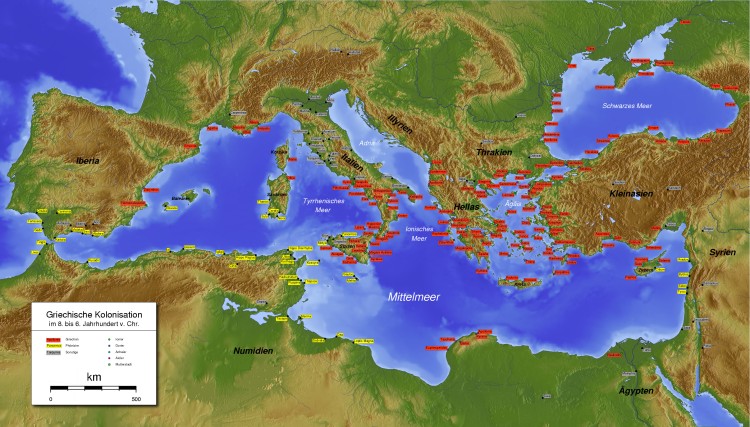
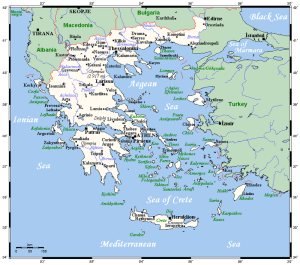
Up until now, I’ve been referring to “the Greeks,” but in antiquity, the Greek world was not a unified entity. There was nothing like the modern nation-state of Greece. The Greek world was a conglomeration of independent city-states (like Athens and Sparta) and somewhat larger territories. They were united to a certain degree by language and culture (although there were substantial regional differences), but they were politically fragmented, and frequently at war with one another.
It was Aristotle’s most famous student, Alexander the Great, King of Macedon (one of those independent Greek territories), who united the Greeks. In his short life (Alexander died at the age of 32), Alexander conquered an area that included not only most of the Greek cities and territories on the first map (although not those on the Italian peninsula), but also Egypt and parts of central Asia and India. He founded at least eleven cities named Alexandria, the most famous one in Egypt. Although Alexander’s empire was highly unstable, and fragmented soon after his death, he did succeed in spreading Greek ideas and philosophy to a far-flung area. Several of the cities he founded became centers of Greek learning and culture. Again, the most famous of these was Alexandria in Egypt, with its legendary Museum (literally a temple to the nine muses) and Library.

Let’s return to the Italian peninsula, a part of the world Alexander did NOT conquer. And in particular, let’s look at the city of Rome. Rome grew from a small town in the 7th century B.C.E. to a large and powerful city by the 4th century B.C.E. By the 3rd century B.C.E., Rome controlled the entire Italian peninsula. By the 2nd century C.E., Rome was the capital city of an empire that extended from northern Africa to Britain, and from Spain to Syria.

Greece was assimilated into Roman Empire, and as the Roman Empire spread over most of present day Europe, much of Middle East, and parts of Africa, Greek philosophy and learning spread over this area. Although Latin was the vernacular (the everyday spoken and administrative language) of the Roman Empire, the language of learning was Greek. Sophisticated intellectual work – in science, mathematics, medicine and philosophy (to name just a few subjects) – was done in Greek (and often by people from the Greek-speaking parts of the Empire). The astronomer Ptolemy, for example, whose work I described in The Mathematical Models of the Greeks, was a Greek-speaking scholar living and working in Alexandria in Egypt, a city that since its founding by Alexander the Great had bee a center for Greek learning. Highly educated people in the Roman Empire spoke and read Greek in addition to Latin and possibly another vernacular language. And the works of Greek philosophers like Aristotle and Plato were still read and taught and discussed and debated. But all of this work was done in Greek. Very few philosophical works were translated into Latin.
The intellectual heart of the Roman Empire – the place where the smartest, most sophisticated, most highly educated people lived – was in the southern and eastern half. These parts included Rome itself, but also Alexandria in Egypt, Athens in Greece, and later Constantinople (modern day Istanbul, Turkey). The northern and western parts – in other words, those regions corresponding roughly to modern day European countries like France and England, were more “primitive” and “backwards” (at least from the Roman standpoint). Knowledge of Greek was rare in these places and the level of literacy and learning was considerably lower than in southern and eastern parts of Empire.

In the fourth century C.E., the Roman emperor Constantine (272 – 337) converted to Christianity, which was initially a small and persecuted Jewish sect. By end of fourth century, Christianity had become the dominant religion in the Empire.
In around 500 C.E., the Roman Empire in the north and west collapsed, after repeated attacks by the indigenous Germanic tribes. Europe (or what would become Europe) lost what little political cohesion and stability the declining Roman Empire had provided. Population declined, the economy stagnated, and levels of learning and literacy plummeted. This was not a world in which high-level philosophy and theorizing about the nature of the cosmos went on! Very few people could read Greek, and much of the philosophy of Plato, Aristotle and their followers, including Ptolemy, was unknown. When the western half of the Roman Empire collapsed, the Christian Church survived. It became the one institution that preserved the unity of the Roman Empire, and was the major supporter and protector of culture and learning in the west for several centuries. Learning and texts were largely preserved in monasteries, but even there literacy was limited. Most literate people were monks or clerics – but not all monks and priests were literate. We will discuss the relationship between Christianity and natural philosophy at great length in the coming weeks.
The Roman Empire in the east continued to function until the fifteenth century. The capital city of this Empire was not Rome, as it had been earlier, but a new city founded by Constantine, Constantinople (modern day Istanbul in Turkey). This Eastern Roman Empire is known as the Byzantine Empire, and it too was officially Christian (although the western and eastern churches continue to be distinct to this day). Unlike the western Roman Empire, where Latin was the official language, the Byzantine Empire was Greek speaking. It was also wealthier and more politically stable than the western half, especially after 500. These two facts combined to make levels of learning and literacy considerably higher in Byzantium than in Europe. The scholars of the Byzantine Empire continued to read Greek texts and did not suffer the same decline in knowledge that Europeans did. Nonetheless, the Byzantine Empire was not Rome at the height of its power and glory. Although the decline in the sophistication of scholarship and the amount of original work was nowhere near as precipitous and disastrous as in Europe, there was a slow but steady diminution in creative and intellectual output.
While the remnants of the Empire in the west sank into poverty and ignorance and the Empire in the east slowly faded, a new intellectually and culturally vibrant civilization emerged. It was this civilization that would pick up where the ancient Greeks left off and continue to develop (among other achievements) mathematics, physics and astronomy to higher levels. This civilization was the Islamic Empire.
The religion of Islam was founded by the prophet Muhammad (570 – 632) in the early seventh century C.E. Like Judaism and Christianity, Islam is both monotheistic (there is only one God), and centered on a holy text, the Koran. For an overview of the basic tenets of Islam and its history, see here. Muhammad began spreading this new religion in Mecca, which is on Arabian peninsula, and it spread rapidly in the seventh and eighth centuries to Egypt and North Africa, Persia (encompassing modern Iraq, Iran, and Turkey), Syria, and as far west as Spain. Before the rise of Islam, the Arabs were divided into different tribes, largely nomadic, and uninterested in expansion. The unity fostered by a shared religion facilitated expansion, conquest, conversion, and commercial activity.

It is common to refer to the region of the world depicted in the map as the “Islamic” world or the “Islamic” Empire. And it is certainly true that Islam was the dominant religion and a powerful cultural force. It was the religion of the rulers and the teachings of Muhammad shaped every aspect of life in this part of the world. However, the Islamic Empire was also characterized by a diversity of religions and ethnicities, and a high degree of tolerance for non-Muslims. Indeed, there were groups of Christians from the Byzantine Empire who were persecuted by other Christians (because their views were deemed “heretical”) who sought and received refuge from Islamic rulers. Similarly, Jews were considerably safer in Islamic territories than they were in Europe. Some very important scientific research and scholarship in the Islamic world was done by Christians and Jews. The use of the term “Islamic” science signals two things: 1) the centrality of Islam to this civilization, and 2) the predominance of Arabic (the language of the Koran) as a scientific language.
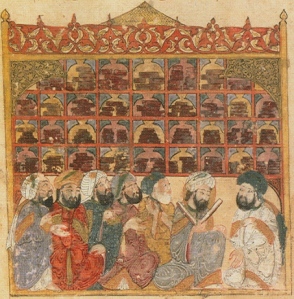
The Islamic world rapidly surpassed Europe (the former western/northern part of the Roman Empire) and the Byzantine Empire in wealth, culture and sophistication. Islamic rulers actively sponsored artists and scholars by bringing them to their courts, and also built schools, libraries and other institutions where research and teaching in many subjects flourished. One area that these rulers were interested in was science (and medicine, which we will discuss later in this course). If you look again at the maps of the Greek world, the Roman Empire and the Islamic world, you will see some areas of overlap. Islamic rulers eventually controlled some areas, like Alexandria in Egypt, which had long been centers of Greek learning. Also, they were in regular contact – both trade and diplomatic – with the Byzantine Empire where Greek learning was still actively pursued. Islamic rulers and the scholars living in their territories were thus aware of the intellectual riches of Greek philosophy, and they wanted to gain access to Greek texts and study them. Many scholars in the Islamic world were multilingual, and were capable of translating Greek texts into Arabic. They also translated Indian and Persian scientific and mathematical texts into Arabic. Beginning in the eighth century, there was a very active translation program, sponsored particularly by the Abbasid rulers, who controlled a territory corresponding roughly to modern Iraq. The Abbasids founded the city of Baghdad in 762. At one point Baghdad, with over a million inhabitants, was probably the largest city in the world. The Abbasids were strong supporters of scholarship. In 832 they established an institution called the House of Wisdom (Bayt al-Hikma). Scholars at the House of Wisdom worked to collect important texts and to translate them into Arabic. Translation work at the House of Wisdom was actually dominated by Christian scholars. The most important of these was Hunayn ibn Ishaq (d. 873). The output of the translation movement in Baghdad was vast in both range and content. Translation may not seem like an important scientific activity because it is about rendering older scientific texts comprehensible to a new audience rather than making new discoveries and coming up with new ideas. However, the translation movement set the stage for the extraordinary flourishing of original scientific work in the Islamic world between the tenth and fifteenth centuries. Translators, like Hunayn ibn Ishaq, made it possible for scholars working in Arabic to build on the accomplishments of the Greeks, rather than having to start from scratch. Also, they transformed Arabic into a scientific language, with a rich technical vocabulary for subjects like astronomy. Translations continued to be made on into the eleventh century, but the pace slowed significantly after about 900.
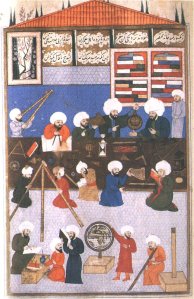
After 900, there was an increasing amount of original scholarship. A huge number of original Arabic treatises on scientific topics were written. We will discuss some of these works in class. Just to give a brief overview, in astronomy Islamic achievements included new observations of celestial movements, the improvement of the Ptolemaic mathematical models, the construction of sophisticated astronomical instruments, and the critique of various anomalies in the Ptolemaic models.
Other Islamic rulers besides the Abbasids supported science and learning. Numerous Islamic rulers created public and private libraries or sponsored the building of schools (madrasas). For example, the rulers of Cairo founded a House of Science in the early eleventh century (akin to the Abbasids’ House of Wisdom in Baghdad), which included a public library. Mosques and madrasas also had libraries, frequently with a wide range of texts.
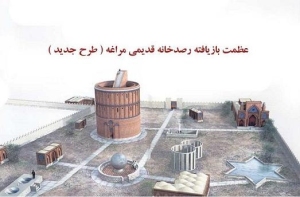
Another crucially important scientific institution in the Muslim world was the observatory. There were numerous observatories throughout the Islamic world. These were scientific institutions with permanent staff, astronomical instruments, and libraries. The most famous of these observatories was the observatory in Maragha (or Maragheh), a city in what is now Iran. This observatory was established in 1259 C.E.

Useful links and references on Islamic science (especially astronomy):
George Saliba’s Whose Science is Arabic Science in Renaissance Europe?
Yale University Library, Near Eastern Collection, Illuminated Islamic Manuscripts
Islamic Astronomers, from the Biographical Encyclopedia of Astronomers (gen. ed. Thomas Hockey wih the assistance of Marvin Bolt, Katherine Bracher, Richard Jarrell, Jordan Marché, JoAnn Palmeri, F. Jamil Ragep, Virginia Trimble, and Thomas Williams). New York: Springer, 2007.
Could you please tell me who is the author of this nice reconstruction of Maragha?
LikeLike
I found it on the following website: http://farabiasl.com/historic-places/36-%D8%B1%D8%B5%D8%AF%D8%AE%D8%A7%D9%86%D9%87-%D9%85%D8%B1%D8%A7%D8%BA%D9%87.html
I will add a link to this site to the image caption.
LikeLike